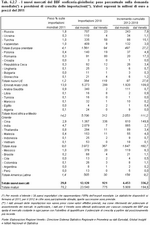Chapter 6
A flywheel for development: Veneto's beautiful and well-made goods in the new markets (Note 1)
With the open wounds from 2008-2009 not yet healed, a new wave of recession invested the Italian economy in 2012. Other economies were affected as well: the GDP of Germany and the UK also slowed down in 2012, while economy activity shrank in France and Spain. Even 2013 is emerging as a year of crisis for the European economy, which has suffered from the weak performance of domestic demand, both on the side of investments and that of consumption.
All of the Italian regions are affected, with different intensity, by the difficult national and European scenario: the uncertain demand prospects upset the pace of investment, the squeeze on household income triggered by budgetary policies and the high rate of unemployment all contribute to bringing household consumption back to historical lows.
The worsening Italian and European economy makes even more imperative the need for Veneto's economy to seek elsewhere the grip necessary to get back on its feet. The considerations set out in the past edition of the Report, about the opportunity for businesses to turn their attention toward the emerging markets, are therefore timelier than ever, as these markets are more dynamic than mature markets and above all are experiencing vast economic and social changes that are altering consumer behaviour in profound ways. Particularly in new markets, a potentially very large spending catchment area derives from the broadening of the middle class. This section of the population is moving toward a more evolved basket of consumption and those kinds of goods that are not of necessity but hold a fascination or even play the role of status symbol. The Veneto Region can use two tools part of its productive DNA to hook on to this potential market demand: a marked tendency toward export activities and an economic fabric rooted in the values of quality, design, and experience inherent in beautiful and well-made products that exert an obvious appeal on new consumers.
Beautiful and well-made (hereinafter called 'BBF' from the Italian 'bello e ben fatto') pertains to middle-to-upper class consumer goods made in Italy according to ancient tradition and artisanship, but also with innovative designs, cutting-edge technologies, high quality standards, and professionalism.
With respect to the analysis presented in the Report of last year (Note 2) , the field of observation regarding BBF mid-high consumer goods has expanded by including, in addition to food, home clothing and textile, footwear and furnishing, two sectors particularly relevant to Veneto's economy: eyewear and jewellery. Similarly to last year, however, our method of analysis takes into account an identical geographic perimeter: 30 Countries that offer a potential market demand thanks to the enlargement of their wealthy upper class and factors such as growing urbanisation and a more significant role of women in consumer choices. The new markets are Russia, Poland, Croatia, Czech Republic, Romania, Ukraine, Hungary, China, Turkey, United Arab Emirates, Saudi Arabia, Tunisia, Slovakia, Bulgaria, Mexico, Brazil, India, Morocco, Kazakhstan, Chile, Colombia, Egypt, Thailand, Libya, Algeria, Peru, Vietnam, Malaysia, Argentina, and Indonesia. We took the following group of 10 mature economies as a term of comparison: Austria, Canada, France, Germany, Japan, United Kingdom, Spain, United States, Sweden, and Switzerland.
Even facing a deep internal consumption crisis, export (Note 3) : numbers show that BBF products represent an important lever for Veneto's economy: in 2012, compared to a 1.6 % growth in total exports, BBF exports increased by 4.7 %, weighing in as 29 % of Veneto's overall exports; while in 2011, BBF impact on total regional exports is 28 %, almost double the national average. In addition, Veneto's BBF export trends by destination area clearly show that growth opportunities should be sought in new markets: in 2012, exports of BBF increased by 8.1 % in emerging Countries, and 4.7 % in mature markets. Further confirmation of its ability to grasp the potential of the demand comes from Veneto's positioning: among emerging Countries, its market share is higher for Russia, the United Arab Emirates, and China, major importers of BBF.
Common to the different BBF sectors (food, clothing, footwear, furnishings, eyewear, and jewellery), Veneto's influence on the new markets of Central and Eastern Europe is approaching the one held on mature economies. This is facilitated by geographical proximity, but also by more consolidated commercial relationships. Some of these Countries, however, are involved in the crisis and in particular in weakness in consumption striking the European economy.
Among the more relevant new markets, Veneto shows greater penetration in Russia, in the food, furnishings and fashion sectors. Such significant presence is favoured by the twofold consideration that Russia has a more numerous middle class with new consumers swayed by a stronger fascination for BBF products than other emerging Countries such as Brazil, China, or India. On the other hand, the potential of the Russian market still presents margins for exploitation linked, for example, to the urban development of different areas from Moscow and St. Petersburg, where major consumption is currently concentrated.
However, in addition to Russia, other Countries are important reservoirs of demand: China, first and foremost, represents the added opportunity of having access to other high potential Asian markets that are more difficult to approach directly (i.e., India, Malaysia, and Vietnam). In China, given the scale of the market, Veneto's BBF products exert considerable weight; Veneto holds a market share of more than 20 % of the Chinese market for the eyewear and jewellery sectors. The Chinese market, however, is not an easy challenge to tackle, especially for small and medium sized businesses: China is a large Country, with large and mutable differences between the various regions resulting from current urbanisation processes, along with sudden and profound changes in lifestyles and consumption experienced by a large section of the population. Inadequate knowledge of these factors could pose the risk of an ineffective market penetration strategy. In addition, there are risks associated with product counterfeiting, difficulties with tariff and other barriers that restrict the entry of imported goods, and complex distribution networks often very expensive to join.
The United Arab Emirates represent another market of great interest where the presence of Veneto's BBF products is relatively low compared to international demand (except for eyewear (Note 4). Margins of expansion are in fact detectable in all sectors, thanks to the growing appreciation of typical made in Italy products, known also through tourism and trade fairs.
Other markets offer growth prospects more directly related to specific areas of Veneto's BBF products: i.e., Brazil for food (wine, in particular), or Mexico for eyewear and jewellery. But even in these cases, protectionist commercial policies and/or insufficient distribution networks limit the penetration of imported products, even in the presence of a significant potential demand.
In years when internal consumption is heavily reduced, aiming at markets where BBF demand is growing very rapidly appears to be a forced choice, but the many difficulties involved require well thought out and shared penetration strategies. For example, one useful tool to overcome the size problem resides in network agreements, while the Made in Italy could be promoted by creating synergies between the different BBF sectors; joint initiatives can be effective in this regard, such as the Buy Made in Veneto project that publicises home system and fashion products on strategic markets. More generally, fairs are proving to be a very useful BBF conveyance tool that may also be local, especially when direct knowledge of businesses and products can reduce the risk of counterfeiting.
All of the Italian regions are affected, with different intensity, by the difficult national and European scenario: the uncertain demand prospects upset the pace of investment, the squeeze on household income triggered by budgetary policies and the high rate of unemployment all contribute to bringing household consumption back to historical lows.
The worsening Italian and European economy makes even more imperative the need for Veneto's economy to seek elsewhere the grip necessary to get back on its feet. The considerations set out in the past edition of the Report, about the opportunity for businesses to turn their attention toward the emerging markets, are therefore timelier than ever, as these markets are more dynamic than mature markets and above all are experiencing vast economic and social changes that are altering consumer behaviour in profound ways. Particularly in new markets, a potentially very large spending catchment area derives from the broadening of the middle class. This section of the population is moving toward a more evolved basket of consumption and those kinds of goods that are not of necessity but hold a fascination or even play the role of status symbol. The Veneto Region can use two tools part of its productive DNA to hook on to this potential market demand: a marked tendency toward export activities and an economic fabric rooted in the values of quality, design, and experience inherent in beautiful and well-made products that exert an obvious appeal on new consumers.
Beautiful and well-made (hereinafter called 'BBF' from the Italian 'bello e ben fatto') pertains to middle-to-upper class consumer goods made in Italy according to ancient tradition and artisanship, but also with innovative designs, cutting-edge technologies, high quality standards, and professionalism.
With respect to the analysis presented in the Report of last year (Note 2) , the field of observation regarding BBF mid-high consumer goods has expanded by including, in addition to food, home clothing and textile, footwear and furnishing, two sectors particularly relevant to Veneto's economy: eyewear and jewellery. Similarly to last year, however, our method of analysis takes into account an identical geographic perimeter: 30 Countries that offer a potential market demand thanks to the enlargement of their wealthy upper class and factors such as growing urbanisation and a more significant role of women in consumer choices. The new markets are Russia, Poland, Croatia, Czech Republic, Romania, Ukraine, Hungary, China, Turkey, United Arab Emirates, Saudi Arabia, Tunisia, Slovakia, Bulgaria, Mexico, Brazil, India, Morocco, Kazakhstan, Chile, Colombia, Egypt, Thailand, Libya, Algeria, Peru, Vietnam, Malaysia, Argentina, and Indonesia. We took the following group of 10 mature economies as a term of comparison: Austria, Canada, France, Germany, Japan, United Kingdom, Spain, United States, Sweden, and Switzerland.
Even facing a deep internal consumption crisis, export (Note 3) : numbers show that BBF products represent an important lever for Veneto's economy: in 2012, compared to a 1.6 % growth in total exports, BBF exports increased by 4.7 %, weighing in as 29 % of Veneto's overall exports; while in 2011, BBF impact on total regional exports is 28 %, almost double the national average. In addition, Veneto's BBF export trends by destination area clearly show that growth opportunities should be sought in new markets: in 2012, exports of BBF increased by 8.1 % in emerging Countries, and 4.7 % in mature markets. Further confirmation of its ability to grasp the potential of the demand comes from Veneto's positioning: among emerging Countries, its market share is higher for Russia, the United Arab Emirates, and China, major importers of BBF.
Common to the different BBF sectors (food, clothing, footwear, furnishings, eyewear, and jewellery), Veneto's influence on the new markets of Central and Eastern Europe is approaching the one held on mature economies. This is facilitated by geographical proximity, but also by more consolidated commercial relationships. Some of these Countries, however, are involved in the crisis and in particular in weakness in consumption striking the European economy.
Among the more relevant new markets, Veneto shows greater penetration in Russia, in the food, furnishings and fashion sectors. Such significant presence is favoured by the twofold consideration that Russia has a more numerous middle class with new consumers swayed by a stronger fascination for BBF products than other emerging Countries such as Brazil, China, or India. On the other hand, the potential of the Russian market still presents margins for exploitation linked, for example, to the urban development of different areas from Moscow and St. Petersburg, where major consumption is currently concentrated.
However, in addition to Russia, other Countries are important reservoirs of demand: China, first and foremost, represents the added opportunity of having access to other high potential Asian markets that are more difficult to approach directly (i.e., India, Malaysia, and Vietnam). In China, given the scale of the market, Veneto's BBF products exert considerable weight; Veneto holds a market share of more than 20 % of the Chinese market for the eyewear and jewellery sectors. The Chinese market, however, is not an easy challenge to tackle, especially for small and medium sized businesses: China is a large Country, with large and mutable differences between the various regions resulting from current urbanisation processes, along with sudden and profound changes in lifestyles and consumption experienced by a large section of the population. Inadequate knowledge of these factors could pose the risk of an ineffective market penetration strategy. In addition, there are risks associated with product counterfeiting, difficulties with tariff and other barriers that restrict the entry of imported goods, and complex distribution networks often very expensive to join.
The United Arab Emirates represent another market of great interest where the presence of Veneto's BBF products is relatively low compared to international demand (except for eyewear (Note 4). Margins of expansion are in fact detectable in all sectors, thanks to the growing appreciation of typical made in Italy products, known also through tourism and trade fairs.
Other markets offer growth prospects more directly related to specific areas of Veneto's BBF products: i.e., Brazil for food (wine, in particular), or Mexico for eyewear and jewellery. But even in these cases, protectionist commercial policies and/or insufficient distribution networks limit the penetration of imported products, even in the presence of a significant potential demand.
In years when internal consumption is heavily reduced, aiming at markets where BBF demand is growing very rapidly appears to be a forced choice, but the many difficulties involved require well thought out and shared penetration strategies. For example, one useful tool to overcome the size problem resides in network agreements, while the Made in Italy could be promoted by creating synergies between the different BBF sectors; joint initiatives can be effective in this regard, such as the Buy Made in Veneto project that publicises home system and fashion products on strategic markets. More generally, fairs are proving to be a very useful BBF conveyance tool that may also be local, especially when direct knowledge of businesses and products can reduce the risk of counterfeiting.
As a measure of the significance of BBF products in the structure of regional exports, consider that this type of goods represented nearly 30 % of Veneto's exports in 2012. (Figure 6.1.1)
Among the end markets, Veneto's BBF products had a still very relevant 59.5 % of their exports in the 10 mature economies, as compared to 19.7 % of the 30 new markets. These percentages, however, are differentiated relatively to different sectors: mature Countries reach 70 % of food exports, whereas the jewellery sector shows its highest impact in the new markets with 41.6 %, as compared to 38.6 % in the mature markets. Regardless of the destination market, however, exports of BBF in the Veneto region are quite significant even with respect to the national average: in 2011, restricting the comparison to the 40 destination markets subject to analysis, BBF products amounted to 28 % of the regional export, as compared to 15 % in Italy. (Figure 6.1.2)
Veneto's BBF products do not play a major role only within the local economy: they account for 24 % of Italian exports going to the 40 end Countries. These percentages are even higher in the jewellery (33.3 %), footwear (28.2 %), furnishings (26.7 %), and especially in the eyewear sector where the Veneto region accounts for 90 % of national BBF exports.
Regional exports of BBF in 2012 have increased to the current values of 4.7 %, more than 3 percentage points compared to the growth of Veneto's overall export. (Figure 6.1.3) (Figure 6.1.4) (Figure 6.1.5)
The food sector (+1.9 %) contributed most to this increase, while clothing, jewellery and eyewear contributed to the growth each by about 1 percentage point; furnishings made a contribution equal to 0.4 %, while footwear was on the negative side (-0.5 %).
In 2012, compared to the overall Veneto regional total, not only have BBF exports turned out to be more dynamic, but they have also evinced a different growth composition among the end markets. The overall export has been relatively more dynamic toward the mature markets (2.1 %) and has grown by a modest 0.6 % toward the new ones, but BBF products aimed at the latter have risen by 8.1 % compared to the 4.7 % that involved the mature Countries. Therefore, these results might indicate a better ability to react to the slowdown/recession that involved the mature European economies in 2012 by Veneto's BBF businesses that aimed most of their exports at areas where the current and perceived future demand shows a higher growth rate. (Figure 6.1.6) (Figure 6.1.7)
Finally, from the point of view of individual industries, Veneto's BBF exports aimed at new markets have grown in 2012 more than those aimed at mature Countries in all sectors with the exception of food and clothing, with particularly large growth differentials in eyewear and furnishings. Footwear evinced a 2.8 % decrease in mature Countries, with a somewhat weak hold in the new markets (+1 %). (Figure 6.1.8) (Figure 6.1.9)
Among the new markets, the Countries that have contributed the most to the growth of Veneto's BBF are China, Russia and the United Arab Emirates, while a weakly negative contribution originates in some European Countries (Romania, Poland, Czech Republic, Croatia and Hungary) characterized by a particular situation of weakness of consumption in 2012. In a number of new markets, in addition, the BBF impact on total exports from Veneto is particularly high: for example, 52 % of Veneto's exports going to the United Arab Emirates are composed of BBF products, and percentages higher than 30 % are recorded for Ukraine and Russia. (Figure 6.1.10)
Among the end markets, Veneto's BBF products had a still very relevant 59.5 % of their exports in the 10 mature economies, as compared to 19.7 % of the 30 new markets. These percentages, however, are differentiated relatively to different sectors: mature Countries reach 70 % of food exports, whereas the jewellery sector shows its highest impact in the new markets with 41.6 %, as compared to 38.6 % in the mature markets. Regardless of the destination market, however, exports of BBF in the Veneto region are quite significant even with respect to the national average: in 2011, restricting the comparison to the 40 destination markets subject to analysis, BBF products amounted to 28 % of the regional export, as compared to 15 % in Italy. (Figure 6.1.2)
Veneto's BBF products do not play a major role only within the local economy: they account for 24 % of Italian exports going to the 40 end Countries. These percentages are even higher in the jewellery (33.3 %), footwear (28.2 %), furnishings (26.7 %), and especially in the eyewear sector where the Veneto region accounts for 90 % of national BBF exports.
Regional exports of BBF in 2012 have increased to the current values of 4.7 %, more than 3 percentage points compared to the growth of Veneto's overall export. (Figure 6.1.3) (Figure 6.1.4) (Figure 6.1.5)
The food sector (+1.9 %) contributed most to this increase, while clothing, jewellery and eyewear contributed to the growth each by about 1 percentage point; furnishings made a contribution equal to 0.4 %, while footwear was on the negative side (-0.5 %).
In 2012, compared to the overall Veneto regional total, not only have BBF exports turned out to be more dynamic, but they have also evinced a different growth composition among the end markets. The overall export has been relatively more dynamic toward the mature markets (2.1 %) and has grown by a modest 0.6 % toward the new ones, but BBF products aimed at the latter have risen by 8.1 % compared to the 4.7 % that involved the mature Countries. Therefore, these results might indicate a better ability to react to the slowdown/recession that involved the mature European economies in 2012 by Veneto's BBF businesses that aimed most of their exports at areas where the current and perceived future demand shows a higher growth rate. (Figure 6.1.6) (Figure 6.1.7)
Finally, from the point of view of individual industries, Veneto's BBF exports aimed at new markets have grown in 2012 more than those aimed at mature Countries in all sectors with the exception of food and clothing, with particularly large growth differentials in eyewear and furnishings. Footwear evinced a 2.8 % decrease in mature Countries, with a somewhat weak hold in the new markets (+1 %). (Figure 6.1.8) (Figure 6.1.9)
Among the new markets, the Countries that have contributed the most to the growth of Veneto's BBF are China, Russia and the United Arab Emirates, while a weakly negative contribution originates in some European Countries (Romania, Poland, Czech Republic, Croatia and Hungary) characterized by a particular situation of weakness of consumption in 2012. In a number of new markets, in addition, the BBF impact on total exports from Veneto is particularly high: for example, 52 % of Veneto's exports going to the United Arab Emirates are composed of BBF products, and percentages higher than 30 % are recorded for Ukraine and Russia. (Figure 6.1.10)
Figure 6.1.1
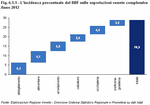
Figure 6.1.2
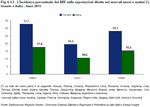
Figure 6.1.3

Figure 6.1.4
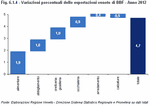
Figure 6.1.5

Figure 6.1.6

Figure 6.1.7

Figure 6.1.8

Figure 6.1.9
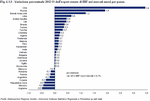
Figure 6.1.10
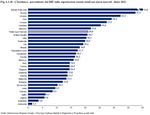
6.2 The new BBF markets: forecasts (Note 5) and future developments for the Veneto Region
Between 2012 and 2018, the new markets will manifest an increase in BBF imports equal to more than 54 billion euros (Note 6) , which correspond to a growth of 47 %, compared to the forecasted 27 % for mature economies. Russia, the United Arab Emirates, and China offer the largest contribution to growth; India, Saudi Arabia, Malaysia, and Mexico's participation is also not negligible. In 2018, Russia will import 24 billion BBF goods, higher than Canada or Spain imported in 2011; the United Arab Emirates, with 17 billion, will exceed the BBF imports recorded in 2011 in Switzerland. In percentage terms, India (81 %) will lead the 2012-2018 growth, followed by Malaysia (66 %), Indonesia (65 %), and Vietnam (63%).
In 2012, the Veneto Region's market share on all BBF imports to new markets is relatively high and equal to 2.2 %. Moreover, Veneto's position is better where demand for BBF is more consistent: taking into consideration the first three importers, in fact, both Russia and China reach 3.3 %, while the United Arab Emirates arrive at 2.8 %. Veneto's effect on markets characterised by better prospects for the growth of demand such as Malaysia and Kazakhstan, as well as Mexico, is less than 1 %.
Taking into consideration the 15 new markets most relevant to Veneto's BBF exports, we observe that the degree of penetration by Veneto's BBF products is greater in relatively closer areas like Croatia, Romania, Tunisia, and Turkey, although, as already pointed out, it is not negligible even in areas such as China, which are more difficult to approach. (Figure 6.2.1) (Figure 6.2.2)
Within this overall framework, taking into account the first 10 new markets importers of BBF foods, Veneto's positioning is better in the Czech Republic, Poland and Russia, areas where its market share is between 1.2 and 1.4 %. The presence of the Veneto Region on the markets of Eastern Europe, made possible also by migration and tourist flows, is now so established that its market shares in this sector are similar to those reached on average in mature Countries.
Veneto holds a relatively more modest share in two other major importers of BBF foods: China (0.4 %) and Mexico (0.1 %). Wine's crucial role is confirmed in Veneto's BBF food exports going into new markets with 27 % and reaching an impact higher than 60 % in China and Brazil. These two Countries represent a reservoir of potential consumers of extreme interest; but the large size and high entry costs that characterize them specifically require targeted and particularly careful penetration strategies in order to protect oneself from the risk of counterfeiting and to find the most effective distribution channels (Note 7) . Wine could also represent the product by which to augment the spread of Veneto's food products in Mexico, a Country characterised by an increase in per capita consumption where Italian wines are enjoying ever-greater popularity next to the predominance of Spanish and Chilean wines (Note 8) .
In Russia, the main new market importer of BBF foods, the Veneto region holds, as mentioned above, not only a relatively significant share of the market but also a greater diversification of exported products: not just wine (34 % of regional exports of BBF foods in 2012), but also pasta (23 %) and cheese (18 %). Therefore, even in a conservative type scenario bound to the concept of the most recent positioning of market shares, Veneto's exports to Russia could reach 65 million euros in 2018. The growth potential of the demand, moreover, should lead in 2018 to 24 million euros in Veneto's exports to China, which will exceed exports to closer and more consolidated markets such as Croatia and Romania. In addition, greater penetration in China could represent a port of entry to Far East Countries that are more difficult to approach directly, but are characterised by prospects of intense growth (Vietnam and Thailand, for example). (Figure 6.2.4)
The burgeoning Russian middle class has significantly increased its propensity for purchases, favouring the development of supermarkets, specialised megastores, and shopping malls (Note 9) . With the growing demand from consumers increasingly sensitive to the charm of Italian fashion, the businesses of the Veneto region that export BBF clothing have responded effectively, gaining a market share of 2.9 % in 2012. In 2018, Veneto's clothing exports to Russia could touch 280 million euros, almost 20 million more than exports to Spain in 2012. (Figure 6.2.5)
Veneto's market shares in the other new importing Countries of BBF clothing are more modest than the effect observed in Russia, but not negligible; consider, for example, the 1.4 % in Poland and especially the 1.3 % in China. A further increase in average incomes is expected in the near future for the latter, which could bring China in 15-20 years into the ranks of high-income Countries (Note 10). After all, the growing development of urban clusters brings with it the emergence of a bourgeoisie prone to improving the quality of their basket of expenditure, and tending more toward goods that are not necessary, but to whose charm they are sensitive. BBF products, in general, but in the fashion sector in particular, represent an optimum response to the needs of the new consumers; however, for individual entrepreneurs (from Veneto and Italy) the Chinese market continues to present significant barriers, such as trade barriers, risk of counterfeiting, complexity of the distribution network, to mention only the most relevant.
The United Arab Emirates represent another area of interest, where Veneto's imports of BBF clothing accounted for 0.6 % in 2012. The demand coming from that area should increase by almost 50 % in the next six years and Veneto's entrepreneurs might benefit from the promotion of the Made in Italy conveyed by the rising tourist flows (business and leisure) that started in Dubai and are now extending into other Sheikdoms. (Figure 6.2.6)
This is another area where Russia plays a prominent role as the confirmed main importer of the new markets in 2012 as in 2018. The development of the middle class has encouraged a diversification of preferences, initially concentrated only on luxury, but now extended to those mid-high products that constitute the core of BBF. The tastes of the Russian female clientele are also changing: attracted no longer just to the fancy shoe, but now also to elegance combined with convenience. Veneto's footwear quality and design was successful in the midst of such transformations, winning the 3.2 % of the market in 2012. (Figure 6.2.7)
Veneto exerts a high impact in other new markets such as Turkey (5.1 %), Croatia (4.4 %) and Poland (2.9 %), while it settles on the 1.8 % in China. As far as China, although it presents good prospects for growth in the demand for this sector, the difficulties of access to the market remain relevant: in the first place, the competition of Chinese producers, but also a fragmented distribution system that is still controlled by local operators. If the way to gain greater visibility resides in the opening of brand stores, this solution seems to be too expensive for small businesses whose only alternative often consists in collaborating with local partners that are not always reliable.
Among the other new markets, a significant growth in demand over the next six years should involve Kazakhstan (72.1 %) and the United Arab Emirates (58.6 %), areas where Veneto holds shares below 1 %. Interest in quality footwear is growing in these Countries, facilitated by expo events, such as the footwear exhibition in Almaty, and, especially in the UAE, favoured by incoming and outgoing tourist flows. (Figure 6.2.8)
Veneto is well placed on the Russian market: in 2012, in fact, 11 % of Russia's demand was satisfied by businesses from Veneto. As already discussed for the fashion system, the increase in the purchasing power of the middle classes and an increasingly international openness favour a contamination of the Russian customers' tastes. Alongside the predilection for opulent Baroque and Rococo inspired furnishings, there begins to take place an interest for more sober forms and styles resembling minimalism, especially among the younger generations. In Russia's near future, we expect development margins in the office furniture sector, which is beginning to reflect very precise needs and trends, and in the industries (hotels, restaurants and various infrastructures) that are inter-linked with the winter Olympics (Sochi 2014) (Note 11) . Diversification of preferences and growth opportunities could take Veneto's exports to Russia to beyond the 386 million euros in 2018 forecasted by the conservative scenario based on the concept of market shares being unchanged from their 2012 positioning.
Veneto's BBF furnishings exports covered 2.2 % of the Chinese market in 2012, and in 2011, they represented nearly 18 % of Italian exports in this sector going to China. In 2018, Veneto's exports to this Country should be nearing 2 billion euros, driven by a growing perception among potential consumers that Italy and Veneto's products are synonymous with artisanship, design, and quality. The further improvement of Veneto's positioning on the Chinese market, moreover, could facilitate an approach to neighbouring markets with high potential such as India and Malaysia, Countries in which, despite a growing sophistication in recent years, the distribution network is still very unsatisfactory, which imposes high market penetration costs.
Even the United Arab Emirates and Saudi Arabia, where Veneto exports BBF furnishings in the 2.8 % and 3.9 %, represent markets of great interest, thanks to the support of the hospitality industry, but also to the expansion of residential construction. (Figure 6.2.10)
Even more than other made in Italy sectors, BBF eyewear is strong on exporting, which is a critical competitive factor in years of such weak domestic consumption.
As undisputed leader of Italian production in this sector, Veneto is very well placed on international markets. Veneto's impact on demand coming from the first three new importers is indeed quite high: 28 % in China, 19 % in Russia, 35 % in Brazil, and shows generally consistent shares in all the major new markets. (Figure 6.2.11)
The greater access difficulties in China reside on one hand in the upgrading of local production, which is beginning to move toward higher refinement, and on the other in the need for direct control over product distribution in order to communicate its image effectively. Nevertheless, thanks to the growing interest in the middle class toward high-quality products and to a parallel increase in health expenditures, there are ample opportunities for development in this Country that may allow Veneto to export 94 million euros to China in 2018.
Demand is expected to increase by 85 % in Russia between 2012 and 2018; it is easier to approach compared to other emerging markets, not only because geographically closer, but also due the more consolidated presence of a clientele sensitive to Italy and Veneto's BBF quality and trendiness. Once again the main obstacles reside in the risk of counterfeiting and the choice of the distribution channels.
Brazil is a market that offers great potential for Veneto; driven by intense growth in demand, Veneto's exports to Brazil in this sector should reach 95 million euros in 2018, substantially similar to those going to China. Product penetration in the Brazilian market is hampered by heavy duties on imports and adversely affected by shortcomings in the distribution network; so much so that some businesses are keen to produce directly in situ.
In 2018, Veneto's eyewear exports should reach their third highest value in the United Arab Emirates (68 million euros) after China and Brazil. For this market, consumer attention on Italian products still concentrates mainly in the luxury range, while it is more difficult to hook on to the intermediate range target, where competition is greater. (Figure 6.2.12)
While assessing the geographic nature of international demand in this sector, it is appropriate to note that jewels imports are conditioned by high trade barriers. Therefore, some Countries that are among the main worldwide importers do not represent a real catchment area, but the key to access other markets that are difficult to reach directly due to controls and onerous duties. The most obvious case of 'bridge Country' is the United Arab Emirates, transit area for Asia; more recently, Turkey and Thailand have also begun to play a similar role.
Having premised this, the challenge for Veneto's jewellery is to identify the demand basins with the highest potential and find the best way to make an entry. Among the Countries characterised by a large growth in the demand, China is expected to increase its imports by more than 80 % between 2012 and 2018 (58 % average in the new markets): China's often-mentioned increased incomes and the dissemination of some commercial type western holidays (i.e., Valentine's Day) provide consumers with new opportunities to purchase jewellery. Aware of these opportunities, Veneto's businesses hold a market share of nearly 25 % in China. Such high impact, along with the growth prospects of the Chinese market, could allow Veneto's exports to come close to 340 million euros in 2018, exceeding the amount going to the United Arab Emirates, Veneto's top export destination Country in 2012.
Russia also offers a not negligible potential demand thanks to a clientele ever more attentive to fashion and the search for unique and innovative products. Because Veneto's effect on this market is relatively restrained (3.3 %), there seems to be room for growth here not yet fully exploited by businesses from Veneto. There exists an analogous situation in the Mexican market, where Veneto's jewels exports are 5.3 %. Here a middle-high income clientele is developing that is particularly interested in quality and elegant design.
(Figure 6.2.14)
(Table 6.2.1)
(Table 6.2.2)
(Table 6.2.3)
(Table 6.2.4)
(Table 6.2.5)
(Table 6.2.6)
(Table 6.2.7)
In 2012, the Veneto Region's market share on all BBF imports to new markets is relatively high and equal to 2.2 %. Moreover, Veneto's position is better where demand for BBF is more consistent: taking into consideration the first three importers, in fact, both Russia and China reach 3.3 %, while the United Arab Emirates arrive at 2.8 %. Veneto's effect on markets characterised by better prospects for the growth of demand such as Malaysia and Kazakhstan, as well as Mexico, is less than 1 %.
Taking into consideration the 15 new markets most relevant to Veneto's BBF exports, we observe that the degree of penetration by Veneto's BBF products is greater in relatively closer areas like Croatia, Romania, Tunisia, and Turkey, although, as already pointed out, it is not negligible even in areas such as China, which are more difficult to approach. (Figure 6.2.1) (Figure 6.2.2)
BBF Foods
With an impact equal to 21 % in 2012, the food sector is the most relevant among Veneto's BBF exports after clothing. Without a doubt, the international resonance of Italy's traditional gastronomy is a flywheel useful to the increasingly widespread dissemination of products from this sector. Also growing in new markets is the sensitivity toward issues of food safety and the appreciation of certified production processes. However, for these potentialities to fully blossom it is necessary to overcome obstacles related to multiple factors. In the first place, there are difficulties related to the durability and portability of goods; but also and above all, especially persistent trade barriers greatly limit the scope of small and medium-sized businesses like those of Veneto (and Italy). In addition, product promotion can be particularly difficult in areas that have a culinary tradition very different from that of Italy, although they may be characterised by prospects of growth in demand as a result of the socio-economic transformations that are occurring. There is still a high risk of counterfeiting by means of products that evoke our gastronomic tradition, but which in fact diverge from it in their essential characteristics and quality standards (the so-called Italian sounding). Finally, another obstacle not to be neglected lies in the distribution network, which in many new markets is deficient and fragmented; add to this the fact that Italy's Large-Scale Distributors show a low international projection, unlike the Large-Scale Distributors of other competitors (see France, Germany and the United Kingdom), who are much more present in foreign markets, including emerging ones. (Figure 6.2.3)Within this overall framework, taking into account the first 10 new markets importers of BBF foods, Veneto's positioning is better in the Czech Republic, Poland and Russia, areas where its market share is between 1.2 and 1.4 %. The presence of the Veneto Region on the markets of Eastern Europe, made possible also by migration and tourist flows, is now so established that its market shares in this sector are similar to those reached on average in mature Countries.
Veneto holds a relatively more modest share in two other major importers of BBF foods: China (0.4 %) and Mexico (0.1 %). Wine's crucial role is confirmed in Veneto's BBF food exports going into new markets with 27 % and reaching an impact higher than 60 % in China and Brazil. These two Countries represent a reservoir of potential consumers of extreme interest; but the large size and high entry costs that characterize them specifically require targeted and particularly careful penetration strategies in order to protect oneself from the risk of counterfeiting and to find the most effective distribution channels (Note 7) . Wine could also represent the product by which to augment the spread of Veneto's food products in Mexico, a Country characterised by an increase in per capita consumption where Italian wines are enjoying ever-greater popularity next to the predominance of Spanish and Chilean wines (Note 8) .
In Russia, the main new market importer of BBF foods, the Veneto region holds, as mentioned above, not only a relatively significant share of the market but also a greater diversification of exported products: not just wine (34 % of regional exports of BBF foods in 2012), but also pasta (23 %) and cheese (18 %). Therefore, even in a conservative type scenario bound to the concept of the most recent positioning of market shares, Veneto's exports to Russia could reach 65 million euros in 2018. The growth potential of the demand, moreover, should lead in 2018 to 24 million euros in Veneto's exports to China, which will exceed exports to closer and more consolidated markets such as Croatia and Romania. In addition, greater penetration in China could represent a port of entry to Far East Countries that are more difficult to approach directly, but are characterised by prospects of intense growth (Vietnam and Thailand, for example). (Figure 6.2.4)
BBF Clothing
Quality clothing is at the top of Veneto's BBF products: 21.8 %. Between 2012 and 2018, BBF clothing and home textiles imports will grow by 43.4 % in the new markets, compared to the 28.3 % of the mature ones; therefore, the new Countries will reach 24 % of world imports at the end of the forecast period. The greatest contribution to growth comes from Russia, which will remain firmly at the top of the ranking of new importers. The United Arab Emirates are in second place with a prospected effect of 10 % on new markets imports in 2018. The third place goes to Kazakhstan with an expected increase in international demand equal to 52 % between 2012 and 2018. The burgeoning Russian middle class has significantly increased its propensity for purchases, favouring the development of supermarkets, specialised megastores, and shopping malls (Note 9) . With the growing demand from consumers increasingly sensitive to the charm of Italian fashion, the businesses of the Veneto region that export BBF clothing have responded effectively, gaining a market share of 2.9 % in 2012. In 2018, Veneto's clothing exports to Russia could touch 280 million euros, almost 20 million more than exports to Spain in 2012. (Figure 6.2.5)
Veneto's market shares in the other new importing Countries of BBF clothing are more modest than the effect observed in Russia, but not negligible; consider, for example, the 1.4 % in Poland and especially the 1.3 % in China. A further increase in average incomes is expected in the near future for the latter, which could bring China in 15-20 years into the ranks of high-income Countries (Note 10). After all, the growing development of urban clusters brings with it the emergence of a bourgeoisie prone to improving the quality of their basket of expenditure, and tending more toward goods that are not necessary, but to whose charm they are sensitive. BBF products, in general, but in the fashion sector in particular, represent an optimum response to the needs of the new consumers; however, for individual entrepreneurs (from Veneto and Italy) the Chinese market continues to present significant barriers, such as trade barriers, risk of counterfeiting, complexity of the distribution network, to mention only the most relevant.
The United Arab Emirates represent another area of interest, where Veneto's imports of BBF clothing accounted for 0.6 % in 2012. The demand coming from that area should increase by almost 50 % in the next six years and Veneto's entrepreneurs might benefit from the promotion of the Made in Italy conveyed by the rising tourist flows (business and leisure) that started in Dubai and are now extending into other Sheikdoms. (Figure 6.2.6)
BBF Footwear
BBF footwear accounts for 13.7 % of the value of Veneto's BBF exports. Between 2012 and 2018, the international demand for this sector in the new markets will grow to 6,104 million euros, similar to the BBF footwear imports that France and the United Kingdom put together in 2011. This is another area where Russia plays a prominent role as the confirmed main importer of the new markets in 2012 as in 2018. The development of the middle class has encouraged a diversification of preferences, initially concentrated only on luxury, but now extended to those mid-high products that constitute the core of BBF. The tastes of the Russian female clientele are also changing: attracted no longer just to the fancy shoe, but now also to elegance combined with convenience. Veneto's footwear quality and design was successful in the midst of such transformations, winning the 3.2 % of the market in 2012. (Figure 6.2.7)
Veneto exerts a high impact in other new markets such as Turkey (5.1 %), Croatia (4.4 %) and Poland (2.9 %), while it settles on the 1.8 % in China. As far as China, although it presents good prospects for growth in the demand for this sector, the difficulties of access to the market remain relevant: in the first place, the competition of Chinese producers, but also a fragmented distribution system that is still controlled by local operators. If the way to gain greater visibility resides in the opening of brand stores, this solution seems to be too expensive for small businesses whose only alternative often consists in collaborating with local partners that are not always reliable.
Among the other new markets, a significant growth in demand over the next six years should involve Kazakhstan (72.1 %) and the United Arab Emirates (58.6 %), areas where Veneto holds shares below 1 %. Interest in quality footwear is growing in these Countries, facilitated by expo events, such as the footwear exhibition in Almaty, and, especially in the UAE, favoured by incoming and outgoing tourist flows. (Figure 6.2.8)
BBF Furnishings
The impact of BBF furnishings on the totality of the BBF products under study is 17.2 %. Although between 2012 and 2018 Russia is expected to have an international demand growth in this sector lower than that observed in average from new markets (54.5 % compared to 68.4 %), at the end of the forecast horizon the Country is confirmed as the first importer of BBF furnishings among emerging Countries. In second place, China, which will arrive at importing more than 3 billion euros in 2018 with an increase of 77 %; while the United Arab Emirates will rise up in the third position, with an increase of 74 %. Particularly encouraging growth prospects come from India and Malaysia, which will see their BBF furnishings imports more than double between 2012 and 2018. (Figure 6.2.9)Veneto is well placed on the Russian market: in 2012, in fact, 11 % of Russia's demand was satisfied by businesses from Veneto. As already discussed for the fashion system, the increase in the purchasing power of the middle classes and an increasingly international openness favour a contamination of the Russian customers' tastes. Alongside the predilection for opulent Baroque and Rococo inspired furnishings, there begins to take place an interest for more sober forms and styles resembling minimalism, especially among the younger generations. In Russia's near future, we expect development margins in the office furniture sector, which is beginning to reflect very precise needs and trends, and in the industries (hotels, restaurants and various infrastructures) that are inter-linked with the winter Olympics (Sochi 2014) (Note 11) . Diversification of preferences and growth opportunities could take Veneto's exports to Russia to beyond the 386 million euros in 2018 forecasted by the conservative scenario based on the concept of market shares being unchanged from their 2012 positioning.
Veneto's BBF furnishings exports covered 2.2 % of the Chinese market in 2012, and in 2011, they represented nearly 18 % of Italian exports in this sector going to China. In 2018, Veneto's exports to this Country should be nearing 2 billion euros, driven by a growing perception among potential consumers that Italy and Veneto's products are synonymous with artisanship, design, and quality. The further improvement of Veneto's positioning on the Chinese market, moreover, could facilitate an approach to neighbouring markets with high potential such as India and Malaysia, Countries in which, despite a growing sophistication in recent years, the distribution network is still very unsatisfactory, which imposes high market penetration costs.
Even the United Arab Emirates and Saudi Arabia, where Veneto exports BBF furnishings in the 2.8 % and 3.9 %, represent markets of great interest, thanks to the support of the hospitality industry, but also to the expansion of residential construction. (Figure 6.2.10)
BBF Eyewear
The value of BBF eyewear represents 15.3 % of all of Veneto's BBF merchandise. Collaboration with stylists and fashion names has transformed eyeglasses from a correction tool to an accessory that personalizes and identifies a look. In the new markets, this perception translates into forecasts of 67 % demand growth over the next 6 years; a relatively large growth should also occur in mature areas that will evince a +53,3 %, a value higher than mature Countries should manifest in other sectors' BBF imports.Even more than other made in Italy sectors, BBF eyewear is strong on exporting, which is a critical competitive factor in years of such weak domestic consumption.
As undisputed leader of Italian production in this sector, Veneto is very well placed on international markets. Veneto's impact on demand coming from the first three new importers is indeed quite high: 28 % in China, 19 % in Russia, 35 % in Brazil, and shows generally consistent shares in all the major new markets. (Figure 6.2.11)
The greater access difficulties in China reside on one hand in the upgrading of local production, which is beginning to move toward higher refinement, and on the other in the need for direct control over product distribution in order to communicate its image effectively. Nevertheless, thanks to the growing interest in the middle class toward high-quality products and to a parallel increase in health expenditures, there are ample opportunities for development in this Country that may allow Veneto to export 94 million euros to China in 2018.
Demand is expected to increase by 85 % in Russia between 2012 and 2018; it is easier to approach compared to other emerging markets, not only because geographically closer, but also due the more consolidated presence of a clientele sensitive to Italy and Veneto's BBF quality and trendiness. Once again the main obstacles reside in the risk of counterfeiting and the choice of the distribution channels.
Brazil is a market that offers great potential for Veneto; driven by intense growth in demand, Veneto's exports to Brazil in this sector should reach 95 million euros in 2018, substantially similar to those going to China. Product penetration in the Brazilian market is hampered by heavy duties on imports and adversely affected by shortcomings in the distribution network; so much so that some businesses are keen to produce directly in situ.
In 2018, Veneto's eyewear exports should reach their third highest value in the United Arab Emirates (68 million euros) after China and Brazil. For this market, consumer attention on Italian products still concentrates mainly in the luxury range, while it is more difficult to hook on to the intermediate range target, where competition is greater. (Figure 6.2.12)
BBF Jewellery
Jewellery represents 11 % of the value for Veneto's BBF exports. Demand for jewellery appears rather differentiated at the international level. Mature markets have been changing their preferences toward the costume jewellery sub-sector (not monitored by the BBF analysis), not only and not so much because of the income squeeze, but rather due to the ever more increasing perception of jewels as fashion accessories to be changed often, whose design is prized over the purity of precious metals. Combined with high quality, the latter represents instead a symbol of achieved social status for the nascent wealthy upper classes of the new markets. (Figure 6.2.13)While assessing the geographic nature of international demand in this sector, it is appropriate to note that jewels imports are conditioned by high trade barriers. Therefore, some Countries that are among the main worldwide importers do not represent a real catchment area, but the key to access other markets that are difficult to reach directly due to controls and onerous duties. The most obvious case of 'bridge Country' is the United Arab Emirates, transit area for Asia; more recently, Turkey and Thailand have also begun to play a similar role.
Having premised this, the challenge for Veneto's jewellery is to identify the demand basins with the highest potential and find the best way to make an entry. Among the Countries characterised by a large growth in the demand, China is expected to increase its imports by more than 80 % between 2012 and 2018 (58 % average in the new markets): China's often-mentioned increased incomes and the dissemination of some commercial type western holidays (i.e., Valentine's Day) provide consumers with new opportunities to purchase jewellery. Aware of these opportunities, Veneto's businesses hold a market share of nearly 25 % in China. Such high impact, along with the growth prospects of the Chinese market, could allow Veneto's exports to come close to 340 million euros in 2018, exceeding the amount going to the United Arab Emirates, Veneto's top export destination Country in 2012.
Russia also offers a not negligible potential demand thanks to a clientele ever more attentive to fashion and the search for unique and innovative products. Because Veneto's effect on this market is relatively restrained (3.3 %), there seems to be room for growth here not yet fully exploited by businesses from Veneto. There exists an analogous situation in the Mexican market, where Veneto's jewels exports are 5.3 %. Here a middle-high income clientele is developing that is particularly interested in quality and elegant design.
(Figure 6.2.14)
(Table 6.2.1)
(Table 6.2.2)
(Table 6.2.3)
(Table 6.2.4)
(Table 6.2.5)
(Table 6.2.6)
(Table 6.2.7)
Figure 6.2.1
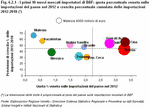
Figure 6.2.2
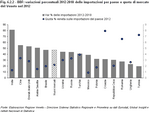
Figure 6.2.3

Figure 6.2.4
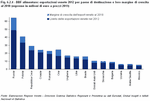
Figure 6.2.5

Figure 6.2.6

Figure 6.2.7
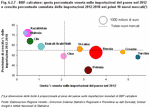
Figure 6.2.8

Figure 6.2.9

Figure 6.2.10

Figure 6.2.11
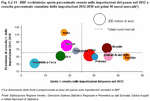
Figure 6.2.12
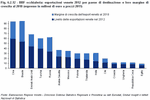
Figure 6.2.13

Figure 6.2.14

Table 6.2.1
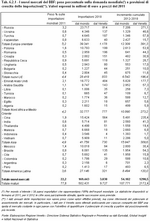
Table 6.2.2
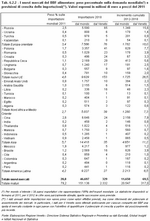
Table 6.2.3
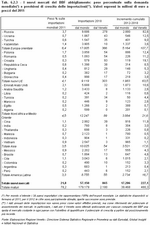
Table 6.2.4
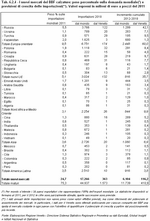
Table 6.2.5
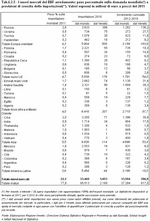
Table 6.2.6
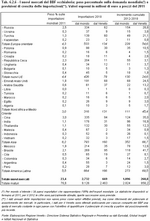
Table 6.2.7
